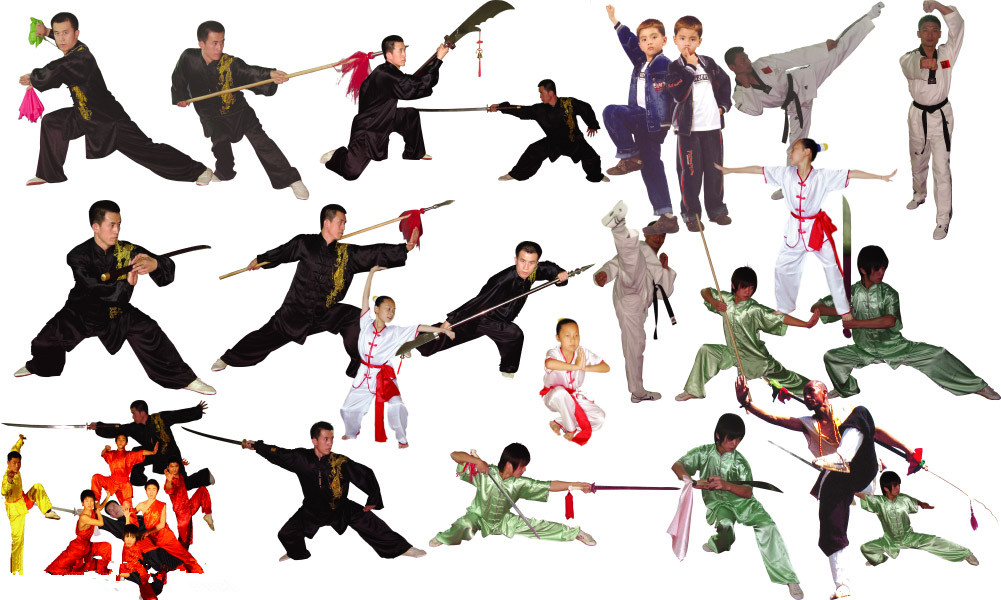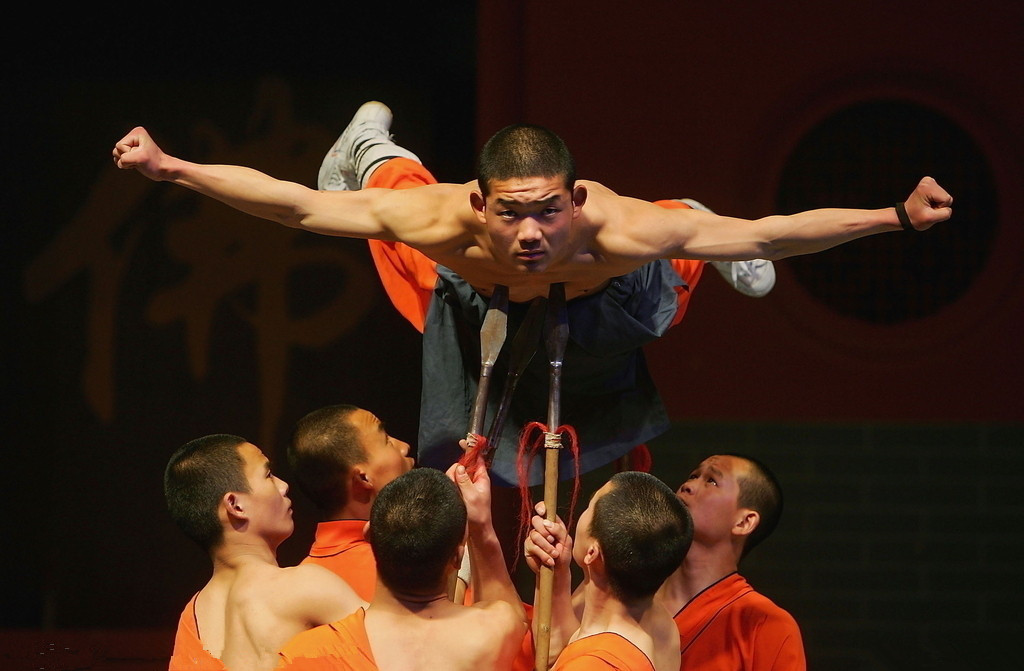Chinese Kung Fu
Chinese Kung Fu, also called Chinese Martial Arts or Wushu, is an important and unique component of Chinese cultural heritage with a rich content that has remained untarnished over the centuries. Literally translated, "wu" is military, "shu" is art. Wushu therefore means the art of fighting, or martial arts.
Chinese Kung fu not only includes physical exercise and training but also Chinese philosophy, meditation and aesthetics. Previously, Kung fu figured significantly in the simple matter of survival through China's many wars and political upheaval. Today, Kung fu has been organized and systematized into a formal branch of study in the performance arts by the Chinese.
Its emphasis has shifted from combat to performance, and Kung fu is practiced for its method of achieving heath, self-defense skills, mental discipline, recreational pursuit and competition.

Main Schools of Chinese Kung Fu
Kung fu appeared in ancient China as early as 2,500 years ago. Because of its long history incorporating differences in culture, ideology, religion and usage, Kung fu has developed into a great variety of schools and styles.
Through its long history, Chinese Kung fu has developed into a number of schools, they generally are:
Shaolin Kung Fu
Shaolin kung fu, originated in the Shaolin Temple, is the most extensive school of Chinese Kung fu with more than 700 kinds of martial arts routines. It is also known as "Martial Zen" because of its zen approach to martial arts and its practice of zen.
In the late Jin Dynasty and the early Yuan Dynasty. The master Jueyuan traveled west to Zhi (now Lanzhou, Gansu Province) and met li Sou, a kung fu master from northwest China. On his way back, he met Bai Yufeng, a kung fu master from Shanxi Province, and brought them back to the Shaolin Temple. Li Sou taught red boxing, gunshu and grappling; Bai Yufeng tought his own martial arts and develops the eighteen hands of Shaolin temple to one hundred and eighty hands. Since then, Shaolin kung fu have been known.
Buddhist culture plays an important role in Shaolin kung fu. The philosophy of "Zen" combine Kung fu to achieve the supreme realm.
Shaolin Kung fu was originally divided into five schools, including Henan (Songshan) Shaolin kung fu, Fujian shaolin kung fu, Guangdong Shaolin kung fu, Emei Shaolin kung fu and Wudang Shaolin kung fu. From the region it can be divided into north Shaolin and south Shaolin.
Shaolin kung fu is rich in content and varied in routines. According to the nature it can be roughly divided into internal, external, hard, light, qigong. The internal skill is mainly to practice qi; External power, hard power refers to exercise a local force; Light skill specializes in vertical jump and distance; Qigong includes practicing qi and nourishing qi. According to the techniques, it is divided into quanshu, gunshu, qiangshu, daoshu, jianshu, acrobatic sanda, instruments and instruments sparring, a total of more than 100 kinds. Many of these routines of kung fu, due to the ages, have been lost.
Tai Chi
Among the many schools of Chinese kung fu, Tai Chi may enjoy the highest popularity. Characterized by gentle, rhythmic movements, natural breathing, physical and mental coordination, it is of particular good to the old and weak, and those suffering from chronic diseases.
There are many schools of traditional Tai Chi kung fu. The common schools are Chen style, Yang style, Wu style, Sun style, Harmony style and so on. Each school not only learns from each other, but also has its own characteristics.
Tai Chi was listed on UNESCO cultural heritage in 2020.
Wing Chun
Like Shaolin kung fu and Tai Chi, Wing Chun is a traditional Chinese kung fu school, which is an aggressive, streamlined self-defense system and a legitimate use of force. Compared with otherChinese kung fu, it focuses more on subduing the opponent as soon as possible to minimize the damage to the party concerned.
Wing Chun is a distinctive southern boxing based on the theory of "the middle line theory", which emphasizes the use of correct concepts, consciousness and thinking mode to lead to the flexible use of the body. A type of training called "Sticking hands" and "sticking feet" is mainly practiced in pairs. Auxiliary equipment of this kung fu training includes wall sandbags, Sanxing piles, wooden stake, knife, stick and so on.
Empty Hand Forms
It involves the performance of a sequence, usually traditional, demonstrating the function and essence of a particular martial style. It can normally fall into the following subdivisions: Long Fist, Taijiquan, Southern Fist, Imitating Styles and some other styles.
Weapon Forms
There are more than 400 different types of ancient Chinese kung fu weapons and many usages of each, but only about 18 standard weapons will be usually seen in Wushu competition. Sometimes a practitioner will combine two weapons in a form or do a variation involving two of the same weapons. Some instances of forms often seen in kung fu competition are: Broadsword, straight sword, spear, staff, Kwan-sword, double-swords, double hook-swords, rope-dart, chained hammer, 3-sectional staff, 2-sectional staff, daggers, double short-staff, etc.
Choreographed Routines (involving 2 or more people)
This kung fu school is more often used by students in order to develop an understanding of the offense, defense, distance, reaction, speed, and so forth of a particular martial style. These forms can be practiced to the extent that spontaneity replaces the more mechanical.
Sparring Competition
Chinese kung fu sparring competition is normally broken down into the following categories:
Bare-hand sparring: with or without protective equipment.
Taiji Push Hands: Stationary, moving, free-style, free-sparring.
Qinna: This joint-locking and controlling is done seated or standing.
Qigong
The category of Qigong involves demonstrations of internal power and strength. Practitioners of this esoteric art demonstrate the powers that internal strength training and breath-training have given them.
Chinese Kung Fu Show
Whether you are a Chinese Kung fu fan or not, you must have watched many kung fu movies or kung fu videos on YouTube or TikTok, but how about a real kung fu show in China? If you plan a China highlights tour with Beijing on your itinerary, you are suggested to include Legend of Kung Fu Show. Plan to visit Luoyang for Shaolin Temple, then a Shaolin kung fu show at its birthplace is definitely a must!

Legend of Kung Fu Show at Beijing Red Theatre - it is a large-scale stage action drama produced by Tianchuang International Performing Arts Production exchange Co., LTD, and integrates Chinese kung fu, acrobatics, traditional dance and other artistic elements.
The Kung fu show mainly show tiger boxing, leopard boxing, snake boxing, duck boxing, monkey stick, eagle boxing, scorpion boxing, toad boxing, single whip, double whip, double hook, crescent shovel and other Chinese kung fu.
Shaolin Temple kung fu show - Shaolin monks are the real masters of Chinese kung fu. They know the essence of Shaolin kung fu and learn from many schools. The shows lasts for about 30 minutes.
Travelers can feed their eyes with the most authentic Shaolin kung fu, from traditional five elements boxing, tiger boxing, the spring and autumn broadsword, shaolin god whips, drunken sword, nine-section whip, three sticks, shaolin knife, shaolin spear, Golden Bell cocoon, 72 iron-cloth hard skills, etc.
Kung fu Schools in China - Where to learn authentic Chinese kung fu Classes
For those that travel to China to learn kung fu, you can select from the many kung fu schools across the country. However, before you decide to go to a school, figure about what kind of kung fu you want to learn. Is it Shaolin kung fu, Tai Chi, or Wing Chun?
To learn Shaolin kung fu, it is better you go to Henan, where there are a handful of kung fu schools. But the best one for international travels must be Shaolin Temple, as you can not only learn authentic kung fu from masters, but also explore the over 1500-year-old temple and experience the Buddhist culture.
To learn Tai Chi, you probably have even more choices, in Henan province, and other places of China. If you are a beginner and wish to learn some simple routines and moves, we can arrange you a Tai Chi teacher at the site of Temple of Heaven or a beautiful park in Guilin. However, if you plan muti days of learning Tai Chi and Tai Chi culture while soaking natural scenery, go and visit Wudang Mountain.
14-day China Kung Fu Tour to Shaolin Temple & Mt. Wudang
Kung Fu benefits -- the person who practices it in both body and mind:
Moral Cultivation: As a human practice stressing cultivation of moral characters and demonstration of spirit and temperament, Chinese kung fu training is conducive to developing good manners and conduct. It also helps adjust one's psychology. The moral characters and etiquette are held in esteem by all schools of kung fu masters.
Offence and Defense: kung fu practitioners can aquire various offence and defense techniques of armed and unarmed combat for self defense through a great number of training exercises. Many Chinese kung fu techniques can also be used in military and police training.
Curative Effect: kung fu exercises emphasize the adjustment of one's breathing, thinking and psychology. These exercises prove to have good curative and rehabilitative effects on contractors of chronic diseases of many kinds. As these kung fu training help strengthen the coordination of the human body and its immunity, they are ideal for preventing and curing diseases.
Health Improvement: Chinese kung fu exercises are effective methods for improving the pliability of the joints and the suppleness of the back and legs. The generation of energy, the jumping and leaping and the changes from one stance to another, all help enhance human strength and speed of movement. Kung fu, therefore, can be taken as the basic exercise for other sporting activities.
Artistic Effect: The graceful movement of the body, especially the typical oriental charm revealed during exercises of kung fu, has an impressive artistic effect and provides visual delight. People can benefit mentally as well as physically from the display of the kung fu performances.
With its graceful movements and salubrious effects on health, Chinese kung fu has a strong appeal to a vast multitude of people at home and abroad. Although still in budding stages in many countries, Wushu is an established international sport. In 1990, kung fu was inducted as an official medal event in the Asian Games. Since then World Championships have taken place with 56 nations participating. Kung fu is also vying for the Olympic Games in the 21st century.
Easy Tour China offers customized China Kung Fu tours with Tai Chi training and Shaolin Kung Fu class for international travelers.